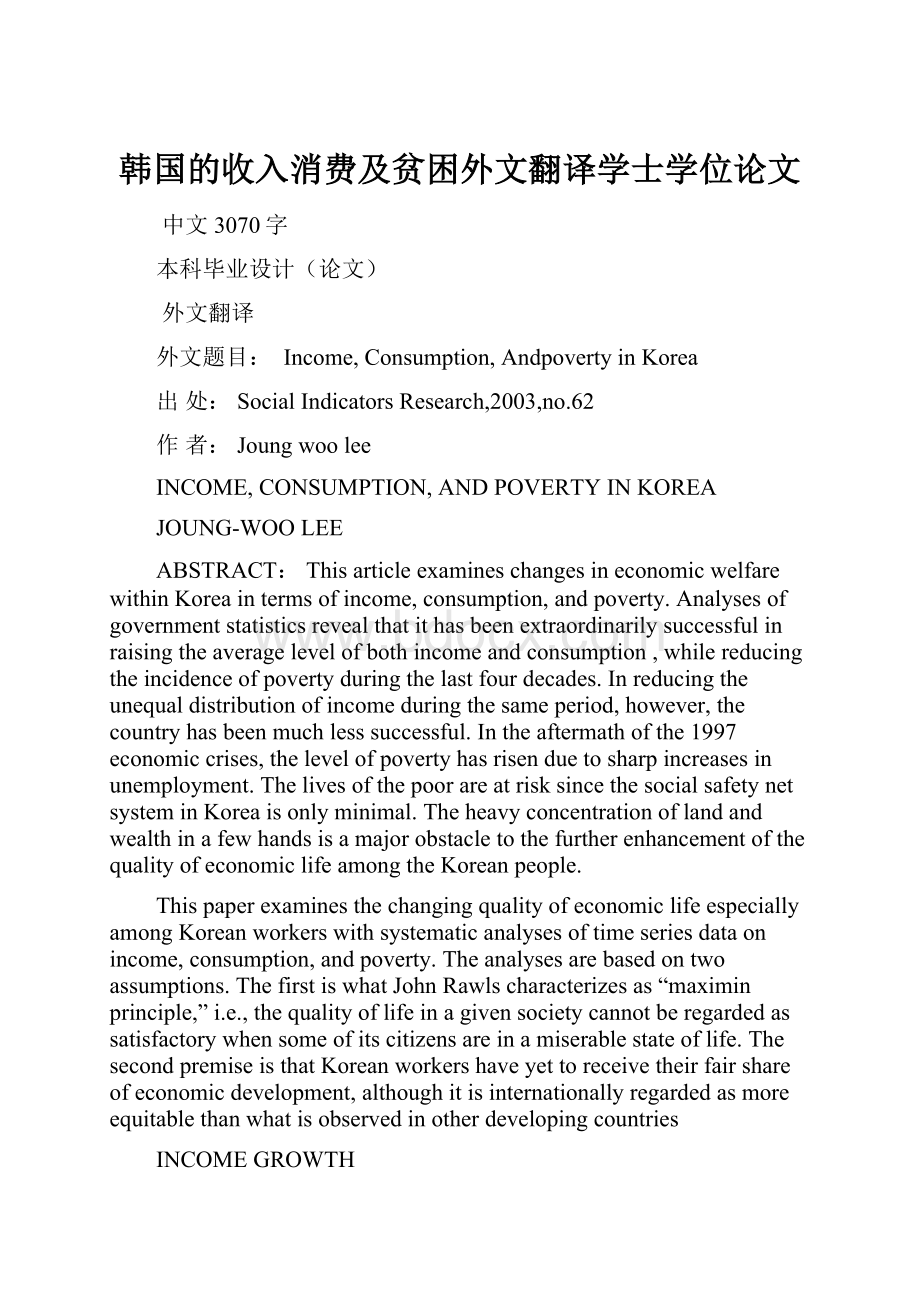韩国的收入消费及贫困外文翻译学士学位论文.docx
《韩国的收入消费及贫困外文翻译学士学位论文.docx》由会员分享,可在线阅读,更多相关《韩国的收入消费及贫困外文翻译学士学位论文.docx(11页珍藏版)》请在冰豆网上搜索。

韩国的收入消费及贫困外文翻译学士学位论文
中文3070字
本科毕业设计(论文)
外文翻译
外文题目:
Income,Consumption,AndpovertyinKorea
出处:
SocialIndicatorsResearch,2003,no.62
作者:
Joungwoolee
INCOME,CONSUMPTION,ANDPOVERTYINKOREA
JOUNG-WOOLEE
ABSTRACT:
ThisarticleexamineschangesineconomicwelfarewithinKoreaintermsofincome,consumption,andpoverty.Analysesofgovernmentstatisticsrevealthatithasbeenextraordinarilysuccessfulinraisingtheaveragelevelofbothincomeandconsumption,whilereducingtheincidenceofpovertyduringthelastfourdecades.Inreducingtheunequaldistributionofincomeduringthesameperiod,however,thecountryhasbeenmuchlesssuccessful.Intheaftermathofthe1997economiccrises,thelevelofpovertyhasrisenduetosharpincreasesinunemployment.ThelivesofthepoorareatrisksincethesocialsafetynetsysteminKoreaisonlyminimal.TheheavyconcentrationoflandandwealthinafewhandsisamajorobstacletothefurtherenhancementofthequalityofeconomiclifeamongtheKoreanpeople.
ThispaperexaminesthechangingqualityofeconomiclifeespeciallyamongKoreanworkerswithsystematicanalysesoftimeseriesdataonincome,consumption,andpoverty.Theanalysesarebasedontwoassumptions.ThefirstiswhatJohnRawlscharacterizesas“maximinprinciple,”i.e.,thequalityoflifeinagivensocietycannotberegardedassatisfactorywhensomeofitscitizensareinamiserablestateoflife.ThesecondpremiseisthatKoreanworkershaveyettoreceivetheirfairshareofeconomicdevelopment,althoughitisinternationallyregardedasmoreequitablethanwhatisobservedinotherdevelopingcountries
INCOMEGROWTH
Koreahasdisplayedunprecedentedrapideconomicgrowthfromthemid-1960supuntilthelate1990s,whenanabrupteconomiccrisishitthecountry.Percapitanationalincomeincreased80-foldfromU.S.$125in1966tooverU.S.$10000in1995.ThiskindofrapideconomicgrowthcouldbefoundonlyinfewEastAsiancountrieslikeHongKong,Singapore,andTaiwan.AnothernotablefeatureofeconomicgrowthinKoreaisthatithasnotbeenaccompaniedbyaworseningdistributionofincome,aswitnessedinmanyLatinAmericancountries
INCOMEDISTRIBUTION
IndividualscholarsandresearchinstituteshavereportedthatincomedistributioninKoreahasimprovedduringthelastcoupleofdecades.TheKoreaNationalStatisticalOffice(hereinaftertheNSO)(2000)andDr.HakchungChoo(1982,1992)oftheKoreaDevelopmentInstituteareinagreementthatincomeinequalityhasbeenloweredinbothruralandurbanareassincethelate1970s.AccordingtotheFarmHouseholdsEconomicSurvey(hereinaftertheFHES,whichisconductedannuallybytheMinistryofAgricultureandFishery,theGinicoefficientwasestimatedtobe0.324for1967,and0.288for1988.Thisstronglysuggestsaloweringofincomeinequalityin
ruralareasoverthepastdecades.Whencombiningtheurbanandruralincomesurveydata,itisevidenthatincomedistributioninKoreahasbeenmovinginthedirectionoflesserinequalitybeforetheeconomiccrisishitthecountryin1997.
Nonetheless,theGinicoefficientsbasedonthesesurveydatahaverecentlybeencalledintoquestion(Ahn,1995;LeeandWhang,1998).Thesesurveyswerenotcapableofproperlyincorporatingtheunearnedincomesstemmingfromthesoaringpricesofland,houses,andstocks.Thewindfallgainsfromthosesourcesoccuronlyonceortwiceinlife,sothatpeopletendtoregardthemas“abnormal”income,thatshouldnotbecountedasincomeinthesocialsurveys.Therefore,itishighlyunlikelythatoccasionalincomesurveyscouldcapturethevastamountofunearnedincome,whichexploredinthelate1980s.Thisisonereasonwhythereisalingeringdoubtaboutthefindingsofimprovingincomedistribution,eventhoughexisting.For1988alone,forexample,therealizedcapitalgainsfromlandwerearound20percentoftheGrossNationalProduct(hereinaftertheGNP),andthosefromthestockmarketaddedanother5percent.TheGinicoefficientof1988,reportedbytheNSO,wasgivenas0.336.However,theGinicoefficientisactuallyestimatedtobe0.388,onethecapitalgainsarisingfromlandinthelate1980saretakenintoaccount(Lee,1991).Thegainsfromtheboomingstockmarketinthelate1980sfurtherraisedthecoefficientto0.412,afigurethatissignificantlyhigherthanwhattheNSOoriginallyestimatedthecoefficienttobe.Inreality,therefore,itishighlyprobablethatincomeinequalityinKoreaismuchhigherthanwhatisknownfromthegovernmentalhouseholdsurveys,andithasbeenworseningduringthepastdecade.
CONSUMPTIONPATTERN
Howdoestheworkingclasscomparewiththenon-workingclassintermsofwhattheyconsumeonadailybasis?
ThepresentstudyaddressedthisquestionwiththeUrbanHouseholdIncomeandExpenditureSurveys(hereinaftertheUHIES)conductedbytheNSOfortheperiodof1963–2000.TableIVcomparestherelativelevelsofconsumptionofthreeworkingclasses–bluecollar,whitecollar,andlaborers–withthatofnon-laborers.Inaddition,thetableprovidestheEngelcoefficient,i.e.,theratiooffoodconsumptionasapartoftotalconsumption,forthesefourclasses.Thereisnostrictcriterion,butoftenanEngelcoefficientover70percentmeans“extremelypoor,”andover50percent“poor.”
AccordingtotheEngelcoefficientsreportedinTableIV,boththeworkingandnon-workingclasseswerepoorduringthe1960s.Theyhadtospendmorethanhalfoftheirlivingexpensesonfooditems.In2000,however,theywerespendinglessthanone-thirdofthoseexpensesforthesamepurpose.TheirEngelcoefficientshavedeclinedtothehigh20s,byasmuchas50percentoverthepastfourdecades.ThisindicatesaremarkableimprovementinthestandardoflivingamongallclassesoftheKoreanpopulation.
Ofthethreeclassessurveyed,blue-collarworkersremaintheleastwelloff,stillspendingthemostonfooditems,thesameastheydidfourdecadesago.Whenimprovementsintheoveralllevelsofconsumptionareconsidered,however,itistheblue-collarworkers,whohaveachievedthegreatestlevelofimprovementintheirstandardofliving.In1963,theywere35percentagepointsbehindnon-laborers.In2000,however,theywereonly16percentagepointsbehind,indicatingagainof19percentagepointsovertheperiodinquestion.
TableVexamineschangesintheconsumptionstructureofworkerhouseholdsafteradjustingforthehousingcoststhatwereunderestimatedintheanalysisreportedbythegovernment.Specifically,theopportunitycostofthelump-sumdepositsandtheimputedrentsofowner-occupiedhousingweretakenintoaccountinordertoestimate,accurately,thepercentagefiguresforfoodandotherconsumptionitems.ThemostnotablefeatureofTableVconcernssteadyandsignificantdeclinesintheEngelcoefficientsfrom55in1963,to21in2000.Asaresultofsuchdeclinesinfoodconsumption,Koreanworkershavebeenabletospendmoreonsuchitemsasmedicalcare,education,transportation,andcommunications.Ofallthosenon-fooditems,therelativelevelofspendinghasincreasedtothegreatestextentinthe“other”consumptioncategory,whichcoversfurniture,electronicequipment,andentertainmentexpenses.Theseitemsaregenerallyconsideredtobeluxuriesratherthannecessities.Thesix-foldriseinthiscategoryfrom2to12percentagepointsisevidenceoftheremarkableimprovementinthestandardoflivingoftheKoreanworkingclassduringthepastfourdecades.Nonetheless,itshouldbenotedthathousingcostshavebecomethesinglemostimportantitemintheworker’shouseholdbudget.Housingandfoodcoststogetherconstitutealmosthalfof
HowdoestheKoreanworkers’standardoflivingcomparewithwhathasbeenobservedintheotherdevelopedanddevelopingcountries?
TheWorldDevelopmentReport(hereinaftertheWDR),publishedbytheWorldBank,providesrelevantdataforacross-nationalcomparison.TableVIsummarizestheconsumptionstructuresofsixty-threecountriesgroupedintofourcategories:
thelow-incomecountries;lower-middle-incomecountries;uppermiddle-incomecountries;andhigh-incomecountries.AccordingtotheWorldBank,Koreacurrentlybelongstotheupper-middleincomegroup.
TableVIcontainsthreeseparateestimatesforKoreabyline.Line
(1)containstheoriginalfiguresreportedinthe1990WDRinwhichKoreawaslistedasanupper-middle-income-economy.Line
(2)liststhefiguresderivedfromthe1985UHIESdata,whichcoverthesameperiodastheWDR.Line(3),ontheotherhand,reportsthefiguresadjustedforhousingcosts.Ofthesethreeestimates,thethirdiswidelyconsideredthemostrealisticone.Intermsofhousingcosts,Koreatopscountriesintheuppermiddleincomegroup,andjoinstheranksofthehighincomegroup(12.5%versus12.9%).Intermsoffoodcosts,Korealooksmoreliketheupperincomegroup(34%versus31%)thanthehighincomegroup.Intermsofexpensesforluxuryitems,listedinthe“other”category,Korearesemblesthelowmiddleincomegroup(21.6%versus22.4%)morethantheupperincomegroup.ThisfindingmakesitclearthatKorea’sappearanceasahighoruppermiddleincomecountryishighlydeceptiveasfarastheoverallqualityofeconomiclifeamongworkersisconcerned.Ascomparedtotheirpeersinaffluentcountries,Koreanworkershaverelativelylesstospendforitemsotherthanbasicnecessities.Inthissense,thequalityofeconomiclifeorstandardoflivingofKoreanworkersdoesnotcomparefavorablywiththatofothercountrieswithsimilarandhigherlevelsoftheGDPpercapita.
Table1:
TheConsumptionStructureofWorkerHouseholds(afteradjustingthe
housingcost)
Source:
Nati